|
|
|
|
|
Intel Penryn: Fast, cool, and “greenish” |
|
Join the community - in the OCAU Forums!
|
More New Features
CPU-Z 1.41 properly recognizes the QX9650 by model name. The CPU-Z screenshot reveals 4 significant changes that come with the Penryn processor family: 45nm production technology, SSE4.1 instructions, processor voltage of around 1.10 at idle and up to 1.25 under load, and 12MB (2x6MB) 24-way set associative L2 cache.
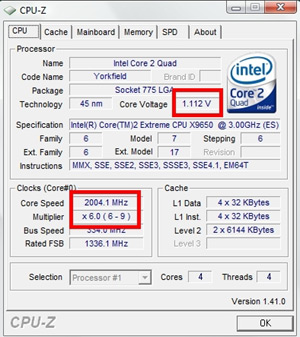 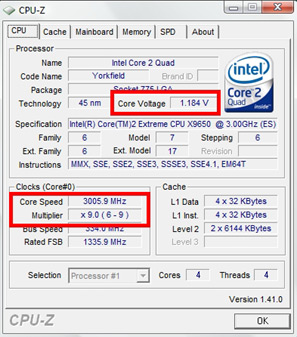
The QX9650 at 2000MHz when idle and 3000MHz under load.
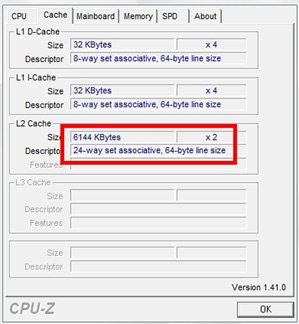 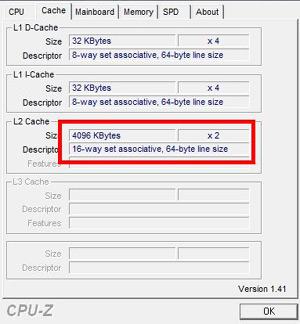
L2 caches: Yorkfield's 2x 6MB (left) vs Kentsfield's 2x 4MB (right)
Shrinking the transistor size from 65nm to 45nm offers various advantages. Firstly it allowed Intel to almost double transistor density. Yorkfield is sporting 820 million transistors on only 214 mm². Kentsfield has 582 million transistors, but measures 286 mm². Another advantage is that 45nm technology allows more dies to be produced from one wafer. Also thanks to the smaller transistor size, Intel could enlarge the L2 cache by 50% and at the same time reduce the die size. Increasing L2 cache means that more data can be stored “on-die” and that the much slower system memory has to be less often accessed. To keep latency and hit rates in the now much larger L2 cache manageable, Yorkfield/Wolfsdale is 24-way set-associative, while Conroe/Kentsfield are only 16-way set-associative.
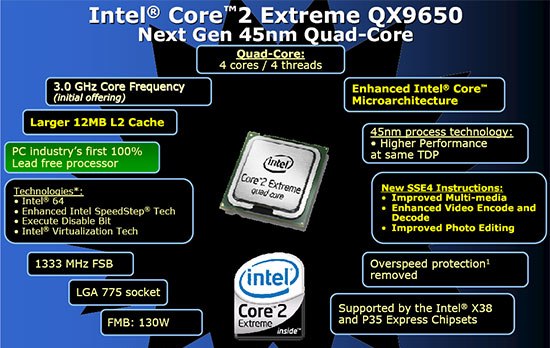
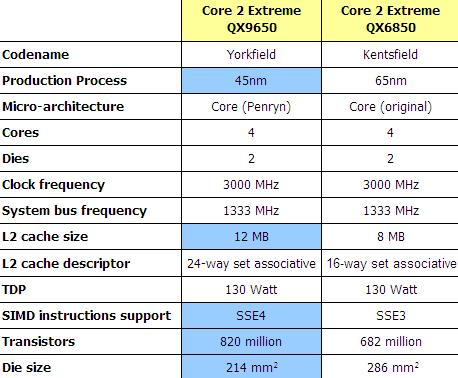
Intel gives a thermal design power (TDP) of 130 Watt for the QX9650. The QX6850 is specified with the same TDP. However, the QX9650 is specified to run between 1.10 and 1.25 volt, which is 0.1 volt lower than the QX6850. How is it possible that Yorkfield requires less voltage and consequently less power, considering that it comes with 40% more transistors? The magic is achieved by using new materials for the transistor gate. The new 45nm transistors have a “high-k” (high-capacitance) gate insulator made of hafnium instead of silicon dioxide. The gate itself is now made of metal instead of silicon. According to Intel the new technology provides for 30% less switching power, 20% faster switching speed and ten times reduced current leakage in comparison to previously used materials. Intel is pointing out that it took them 10 years of research to develop this technology and calls the new design “the biggest advancement in transistor technology since the late 1960s”.
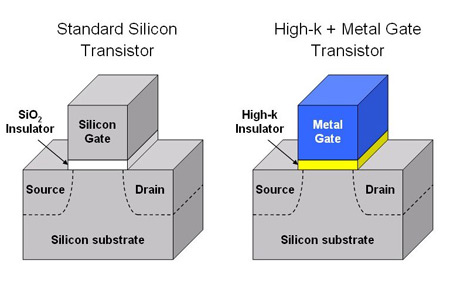
The Penryn processor family is based on what Intel calls an “enhanced Core micro-architecture” with some significant improvements. The most important one is the addition of 47 new SMID (Single Instruction Multiple Data) instructions, called SSE4.1. It’s the biggest addition since 2000. SSE4.1 will improve multi-media performance, media encoding, and image processing. Regardless of all the other improvements we have discussed so far, SSE4.1 is responsible for the biggest performance boost, as we will demonstrate later. Incidentally, the entire SSE4 set has 54 new instructions. The full set will be implemented as SSE 4.2 with the Nehalem micro-architecture at the end of 2008.
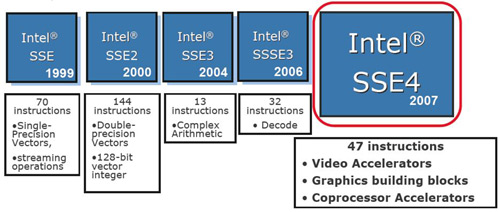

The Penryn processor family received in addition to SSE4.1 a few minor internal execution tweaks as well. This is mainly a radix-16 based divider for faster integer and floating point division and a new SSE algorithm that allows 128-bit instructions to be executed twice as fast as before. Furthermore Intel improved the “virtualization” of hard disk partitions so that the system can run separate operating systems in each partition to act as many virtual computers. Intel is claiming to have reduced the transition time (entry/exit) between virtual machines by up to 75 percent.

Intel is touting Penryn as “the industry’s first lead-free” processor. “Lead-free” means less toxic waste. It’s also necessary to comply with upcoming RoHS directives. Being lead-free in combination with the currently lowest power consumption makes a Penryn processor maybe not a exactly a “green” CPU, but certainly the most environmentally friendly desktop processor currently available.
In a nutshell: In comparison to its predecessor a Penryn die is 25% smaller, comes with 40% more transistors, has a 50% larger L2 cache, consumes less power, boasts 47 new SMID instructions and other internal execution tweaks. Oh yes, we forgot to mention that the retail QX9650 comes with a new designed, bigger heatsink. The new sink has an enlarged diameter of now 135 mm, stands 80 mm high, and comes with thinner fins. To accommodate the much bigger heatsink the QX9650 retail box is almost the size of a shoebox. We don’t know yet whether all Penryn processor will retail with the new sink, but obviously at least the quadcore versions will do so.
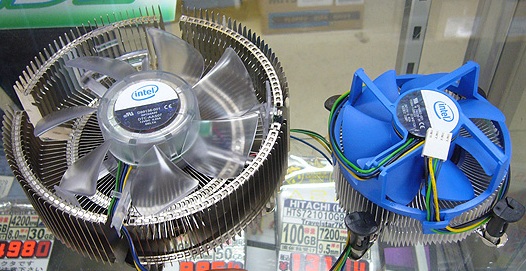
Left: new heatsink - Right: old heatsink

These last two pictures were courtesy Akiba PC Hotline.
|
|
Advertisement:
All original content copyright James Rolfe.
All rights reserved. No reproduction allowed without written permission.
Interested in advertising on OCAU? Contact us for info.
|

|


